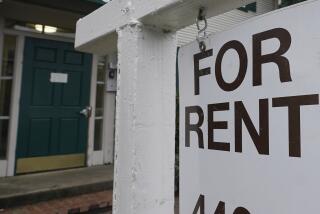Opinion: California just banned ‘crime-free’ housing. Here’s why other states should too

- Share via
Landlords across the country have been empowered to act as a kind of police force in the name of crime prevention for decades. How? Through local “nuisance property” laws and “crime-free housing” programs that require them to evict tenants for vaguely defined “criminal activities.”
As of Monday, California became the first state in the nation to ban so-called crime-free housing programs. More states should follow suit.
Such laws target low-income and minority renters for eviction and violate their civil rights. That’s bad enough. But they also fail to reduce crime.
As we start a new year after a particularly brutal, troubling 12 months, we’re looking for a bit of hope.
Cities across the country have been implementing these policies for about 30 years, building on the Anti-Drug Abuse Act of 1988, which stepped up evictions in federally subsidized housing. By 2019, about 2,000 American cities had a crime-free housing program, and 37 of the 40 largest U.S. cities had a nuisance property ordinance.
Even as these policies spread, their efficacy was in doubt. I led a recent analysis of California’s crime-free housing policies that found they had no effect on crime. Other researchers have found that by driving people into desperation and homelessness, nuisance property ordinances may actually increase property crime.
Crime-free housing policies backfire partly because they treat 911 calls as an indicator of criminal activity. This creates a perverse incentive: For fear of being evicted, tenants don’t call authorities when they need them.
Lawmakers have gotten the message. Voters want and expect them to fix the state’s housing and homelessness crisis.
This particularly harms victims of domestic violence, who may hesitate to seek help from police lest they lose their housing. These policies can also dissuade tenants from seeking medical aid during drug overdoses or mental health crises. Evictions also hamper crime prevention by disrupting community social networks, making it harder for residents to monitor what’s going on in their neighborhoods — a critical element of crime prevention.
My study of California found that city blocks with apartments certified as crime-free saw 21% more evictions than blocks without such housing. Other researchers have found that nuisance property ordinances increase eviction filing rates by 16%. In the six months after the U.S. Department of Housing and Urban Development instituted a “One Strike and You’re Out” policy on criminal activity in 1996, reported evictions from public housing surged 40%.
Evictions are deeply harmful in many ways. People who are evicted struggle to find housing again, and tenants removed from public housing are prohibited from receiving housing assistance. That can lead to more homelessness and desperation. Evictions also cause disproportionate housing insecurity for children, more unemployment, additional use of emergency room resources, and accidental drug and alcohol deaths.
Legal experts have argued persuasively that punishing people with eviction instead of through criminal justice procedures also denies them due process. These policies don’t require an arrest or conviction or even an indication of crime anywhere near the property. They don’t even require a crime.
People have been evicted under crime-free housing policies over kids playing basketball or jumping on a trampoline and because of complaints about barbecues. Tenants can even face severe consequences for the behavior of their guests. One federal court case concerns an Illinois city trying to evict a family because of a burglary committed by a friend of their teenage son who had slept on their couch.
The policies tend to be selectively enforced, with low-income, multifamily properties bearing the brunt. This has led the Department of Justice to take action against cities for violations of the Fair Housing Act and other federal laws. In 2022, the San Bernardino County city of Hesperia signed a consent decree with the federal government related to selective application of its crime-free housing program. Lawsuits have been filed on similar grounds against cities in Washington, Illinois, Pennsylvania and Minnesota.
What is the point of these harmful policies if they aren’t reducing crime? Public officials have suggested their real goal is segregation.
A Hesperia official acknowledged that the purpose of the city’s crime-free housing program was to remove what he described as “those kind of people” and “improve our demographic.” The mayor of Bedford, Ohio, said the city’s nuisance property ordinance was about taking “pride in middle-class values” and curtailing “urban immigration.” The analysis I led found that cities with crime-free housing programs had larger Black populations and that the affected apartments were on lower-income blocks with larger Black and Latino populations.
HUD has issued guidance to cities on how these policies may violate the Fair Housing Act by disproportionately evicting women, victims of crime and people with disabilities. But more needs to be done.
Following California’s lead, other states should limit evictions under these policies without an arrest or conviction or based on the behavior of nonresidents. Cities should also be required to report the number of evictions resulting from crime-free housing policies and nuisance ordinances. Similar federal policies also need reconsideration, including the one-strike policy for public housing and the rules that prevent evicted tenants from obtaining future housing assistance.
These policies and the evictions they cause are at best an ineffective means of preventing crime. At worst, they’re a harmful form of discrimination that leads to more crime and homelessness. Ending them could make all our communities safer.
Max Griswold is a policy researcher at the Rand Corp.
More to Read
A cure for the common opinion
Get thought-provoking perspectives with our weekly newsletter.
You may occasionally receive promotional content from the Los Angeles Times.












